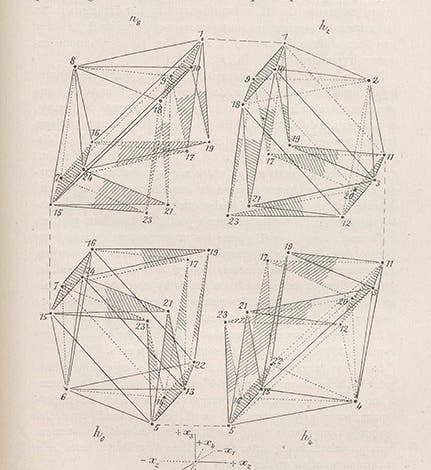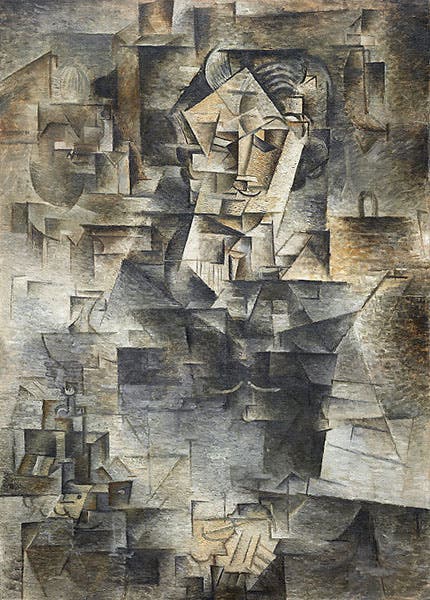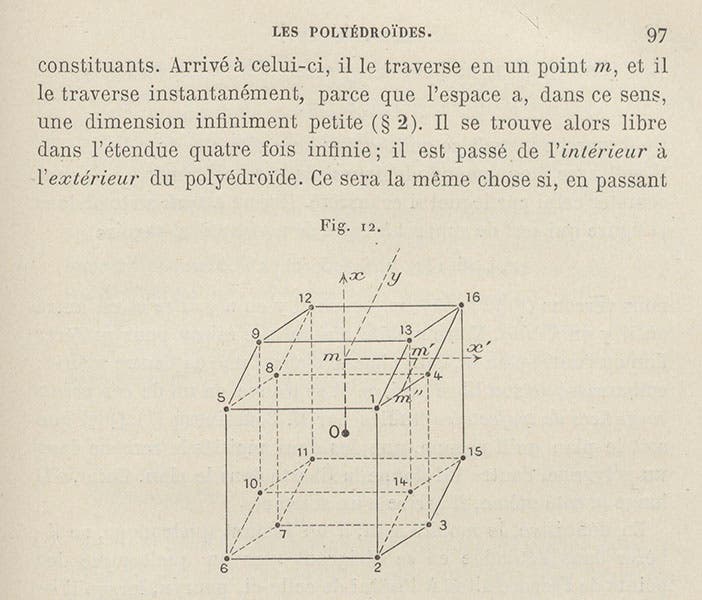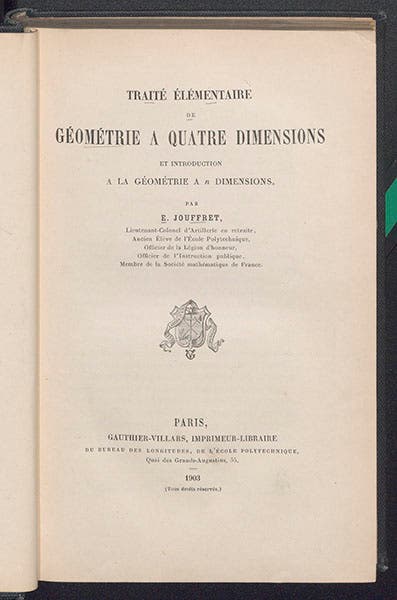Scientist of the Day - Esprit Jouffret
Esprit Jouffret, a French mathematician, was born Mar. 15, 1837. In 1903, Jouffret published a book entitled Traité élémentaire de géométrie à quatre dimensions (Elementary Treatise on the Geometry of Four Dimensions). In this work, which we have in our History of Science Collections, Jouffret attempted to discuss and illustrate how four-dimensional objects would appear when projected onto three-dimensional space. For example, a cube in three-dimensional space has six faces, each one a square; a hypercube, in four-dimensional space, has eight “cells,” as a three-dimensional face is called, each one a cube. How does a hypercube look to an observer confined to three dimensions? Or a hyper-octagon? Or any other of the six regular four-dimensional polygons? That is what Jouffret attemped to work out and demonstrate, using projective geometry. The best part of the book for those not mathematically skilled, are the many geometric diagrams of jagged hyper-octagon projections and exploded hypercube faces.
Sometime before 1983, an American art historian, Linda Henderson, noticed a striking resemblance between one of Jouffret's diagrams (first image) and a painting by Pablo Picasso, A Portrait of Ambroise Bollard, completed in the spring of 1910 (second image). Many before had noticed the geometric nature of cubism – who could not? – but Henderson went further, discovering that Picasso had been introduced to Jouffret's book by a mathematician in his entourage, Maurice Princet, and that Picasso had actually read the book and had been inspired by it to break down the face of Ambroise Bollard into Jouffret’s exploded octahedral faces. Henderson’s book was called: The Fourth Dimension and Non-Euclidean Geometry in Modern Art (1983).
Henderson then considered a portrait that Picasso completed six months later, Portrait of Henry Kahnweiler (1910; third image), which was quite different in the way the image was geometrically broken down. She found the inspiration for this elsewhere in Jouffret’s book – we reproduce here (fourth and fifth images, below) two of the figures she identified as possible sources for Picasso’s new cubist approach.
In the years since, Henderson’s conclusions about Jouffret’s importance for Picasso’s cubism seems to have been generally accepted by art historians. A more recent book by Tony Robbin, Shadows of Reality: The Fourth Dimension in Relativity, Cubism, and Modern Thought (2006) gives a full stamp of approval to Henderson’s scholarship. Not being qualified to judge myself, I can only hope they are both right. True interactions between science and art are in actuality quite infrequent, and it is nice to have another one substantiated, or at least well argued.
Although our library owns Jouffret’s book, and one other by him, we do not, surprisingly, have either Henderson’s or Robbin’s book – perhaps they seemed too art-historical to belong in a science library. Fortunately, I own Robbin’s book and used it to prepare this essay. I have not been able to lay my hands on Henderson’s seminal work; I hope to do so one day soon.
If you wonder how two-dimensional artists see three-dimensional space, you might be interested in our post on Edwin Abbott Abbott, author of Flatland: A Romance of Many Dimensions (1884).
Dr. William B. Ashworth, Jr., Consultant for the History of Science, Linda Hall Library and Associate Professor emeritus, Department of History, University of Missouri-Kansas City. Comments or corrections are welcome; please direct to ashworthw@umkc.edu.










